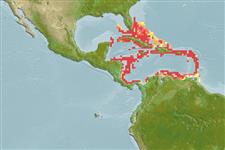>
Eupercaria/misc (Various families in series Eupercaria) >
Lutjanidae (Snappers) > Apsilinae
Etymology: Apsilus: Greek, apsilos, -e, -on = hairless, shorn, peeled (Ref. 45335).
More on author: Guichenot.
Environment: milieu / climate zone / depth range / distribution range
Écologie
marin récifal; profondeur 40 - 300 m (Ref. 129909), usually 120 - 180 m (Ref. 55). Tropical; 29°N - 8°N, 98°W - 59°W
Western Central Atlantic: West Indies, Florida Keys, western Gulf of Mexico, western Caribbean (off Belize), probably more widespread in Caribbean (Anderson, pers. comm.).
Length at first maturity / Taille / Poids / Âge
Maturity: Lm 40.0 range ? - ? cm
Max length : 65.0 cm TL mâle / non sexé; (Ref. 55); common length : 40.0 cm TL mâle / non sexé; (Ref. 55); poids max. publié: 3.2 kg (Ref. 40637)
Épines dorsales (Total): 10; Rayons mous dorsaux (Total): 9-10; Épines anales 3; Rayons mous anaux: 8. The snout is relatively short and pointed. Anterior teeth in upper jaw enlarged, canine-like. Interorbital space convex. Dorsal and anal fin bases without scales. Pectoral fins long reaching level of anus. Scale rows on back parallel to lateral line. The back and upper sides violet or dark brown becoming lighter ventrally. Juveniles are mainly blue in color.
Adults inhabit mainly rocky bottoms. Young sometimes found near the surface. Feed on fishes and benthic organisms, including cephalopods and tunicates. Flesh of good quality; marketed fresh and frozen.
Life cycle and mating behavior
Maturité | Reproduction | Frai | Œufs | Fécondité | Larves
Allen, G.R., 1985. FAO Species Catalogue. Vol. 6. Snappers of the world. An annotated and illustrated catalogue of lutjanid species known to date. FAO Fish. Synop. 125(6):208 p. Rome: FAO. (Ref. 55)
Statut dans la liste rouge de l'IUCN (Ref. 130435)
Menace pour l'homme
Reports of ciguatera poisoning (Ref. 31172)
Utilisations par l'homme
Pêcheries: intérêt commercial mineur
Plus d'informations
RéférencesAquacultureProfil d'aquacultureSouchesGénétiqueElectrophoresesHéritabilitéPathologiesTraitementNutrientsMass conversion
Outils
Articles particuliers
Télécharger en XML
Sources Internet
Estimates based on models
Preferred temperature (Ref.
123201): 19 - 23.7, mean 22.2 °C (based on 12 cells).
Phylogenetic diversity index (Ref.
82804): PD
50 = 0.7500 [Uniqueness, from 0.5 = low to 2.0 = high].
Bayesian length-weight: a=0.01096 (0.00555 - 0.02168), b=3.02 (2.84 - 3.20), in cm total length, based on LWR estimates for this species & (Sub)family-body (Ref.
93245).
Niveau trophique (Ref.
69278): 4.1 ±0.52 se; based on food items.
Generation time: 1.7 ( na - na) years. Estimated as median ln(3)/K based on 1
growth studies.
Résilience (Ref.
120179): Milieu, temps minimum de doublement de population : 1,4 à 4,4 années (K=0.3).
Fishing Vulnerability (Ref.
59153): Low to moderate vulnerability (28 of 100).
Nutrients (Ref.
124155): Calcium = 35.3 [19.0, 63.5] mg/100g; Iron = 0.653 [0.331, 1.126] mg/100g; Protein = 19.1 [17.2, 20.9] %; Omega3 = 0.17 [0.11, 0.28] g/100g; Selenium = 56.7 [32.8, 105.0] μg/100g; VitaminA = 68 [24, 230] μg/100g; Zinc = 0.757 [0.521, 1.091] mg/100g (wet weight);
